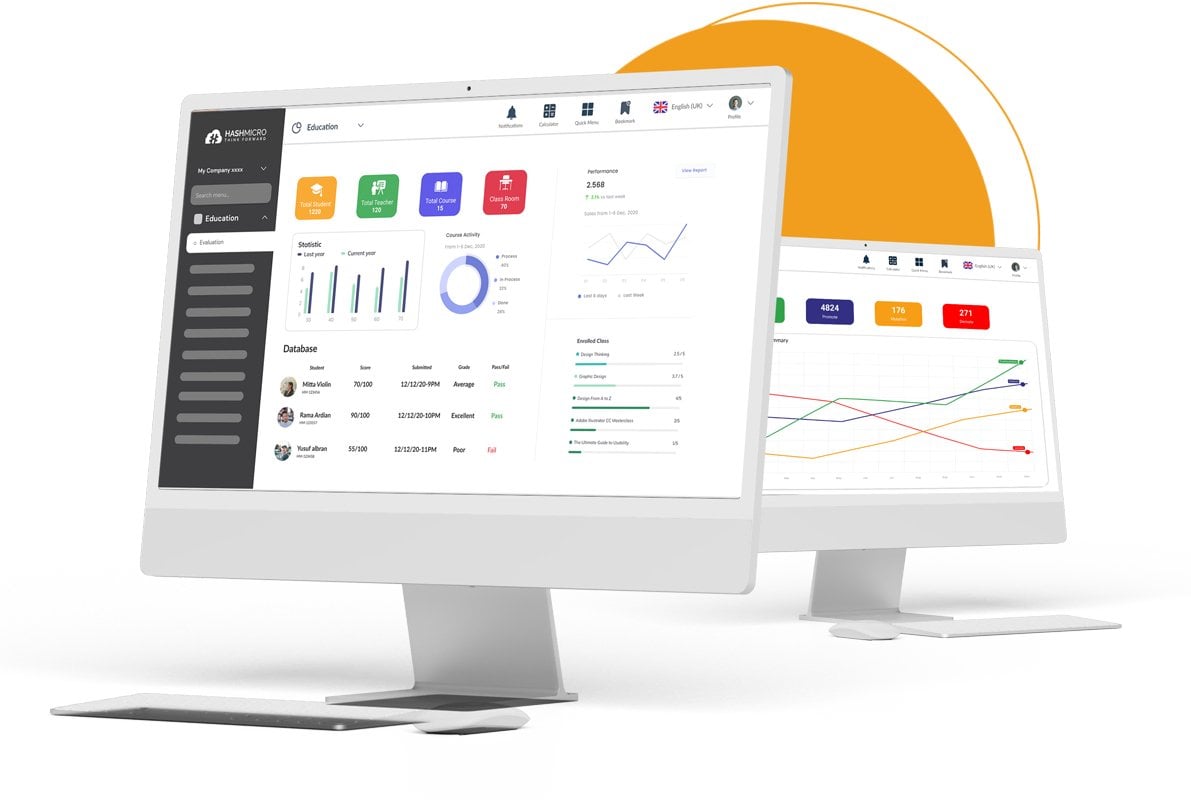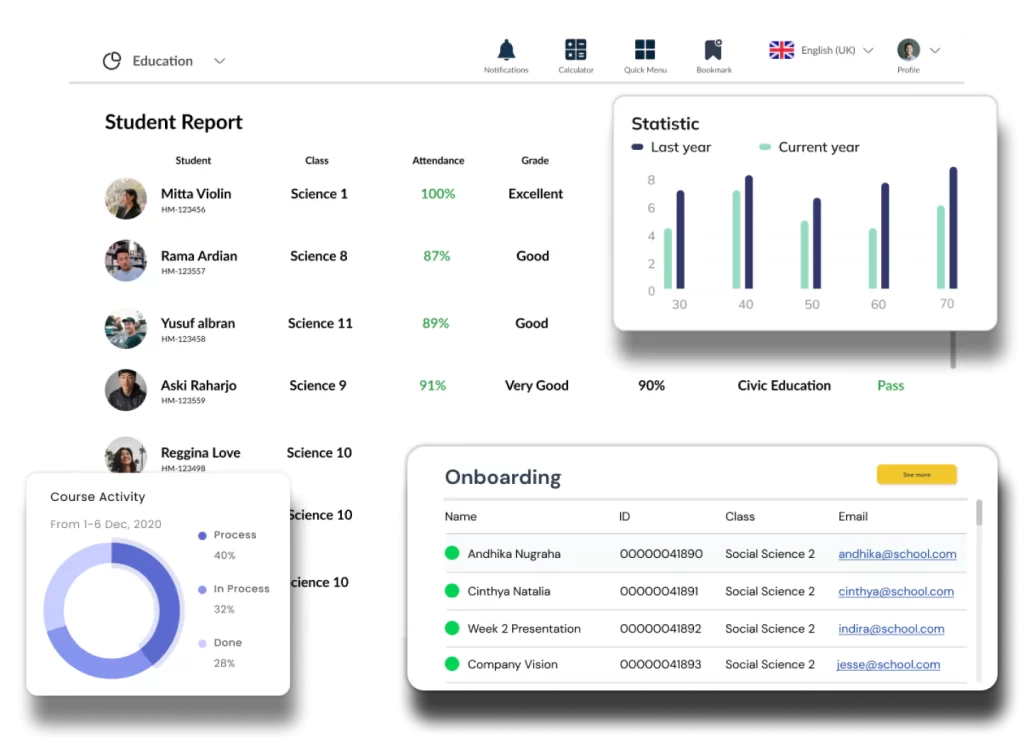In Singapore’s education scene, I see how a school management system streamlines tasks and strengthens collaboration among all stakeholders. For me, this shows the importance of educational management in fostering school-home partnerships for holistic student growth.
I believe Singapore’s push for technology fits well with school management systems. A centralized platform enables smoother communication, planning, and resource use for a well-organized learning environment.
From my perspective, HashMicro’s school management system is a top choice, offering features such as scheduling, attendance, finance, and communication. Try our free demo to see how it can benefit your school in Singapore.
Key Takeaways
|
What is a School Management System?
From my perspective, a School Management System streamlines and automates key administrative and academic processes. I find features like attendance, grading, communication, and fee management essential for improving school efficiency.
By integrating these processes into a centralized platform, the top school management software enhances efficiency, fosters collaboration among teachers, staff, students, and parents, and supports the overall management of the school.
Types of School Management
I’ve seen how different types of SMS support various aspects of school operations. By understanding their distinctions and benefits, I can help schools choose the right tools to boost efficiency, enhance student learning, and streamline administration.
1. Student information system (SIS)
A Student Information System stores and manages detailed student records, including grades, attendance, and personal information. This foundational component of a school management system supports educators in tracking student progress and ensuring compliance with educational standards.
2. Learning management system (LMS)
An LMS facilitates online learning by organizing and delivering course content, assignments, and assessments. Integrating with a school management system enhances learning experiences, provides centralized access to resources, and improves communication between students and teachers.
3. Finance and accounting system
This component of a school management system handles financial tasks like tuition billing, payroll, and budgeting. It streamlines the financial processes, reduces manual errors, and ensures financial transparency across the institution.
4. Human resource management system (HRMS)
The HRMS component manages staff-related functions, including recruitment, payroll, performance evaluations, and compliance. By integrating HR tasks with the overall school management system, schools can improve efficiency and promptly meet staffing needs.
Benefits of Using a School Management System
From my experience, a school management system centralizes administrative, academic, and operational tasks to boost efficiency and performance. I’ve found it essential for schools embracing digital transformation to streamline workflows and improve communication.
1. Centralized data management
A school management system consolidates all student, staff, and academic data into one platform, making it easy to access and manage. This reduces errors, saves time, and provides better insights into student performance, attendance, and academic progress.
2. Automation of administrative tasks
Routine tasks like attendance tracking, grading, and scheduling are automated within an SMS, reducing the manual effort required by school staff. This saves time and ensures that administrative duties are performed consistently and accurately.
3. Improved communication
An SMS enhances communication between teachers, students, and parents by providing a unified platform for updates on assignments, grades, school events, and notices. It facilitates quicker resolution of issues and strengthens stakeholder relationships, contributing to a more supportive educational environment.
4. Real-time data access and decision making
School management systems allow administrators and educators to access real-time student progress, attendance, and behavior data. This access enables faster decision-making, helping to identify students who need additional support or intervention early on.
20 Importance of School Management System in Singapore
I see many schools now considering the right software to boost their activities and learning systems. From my perspective, checking the school management software system pricing scheme helps estimate the budget effectively, and the points below can reassure you if you’re planning to implement one.
1. Attendance record just in a few clicks
Recording and reviewing student attendance is a core feature of a student attendance system, helping teachers generate automatic reports. With SMS notifications for absences, parents stay informed—whether their child is sick, on leave, or skipping class—making it a simple yet effective disciplinary tool.
2. More organized (online) materials with school management system
The education management system enables students to upload, download, and complete assignments, as well as access shared notes and materials at any time. With the e-learning management feature, digital access replaces heavy textbooks, allowing students to learn more efficiently and protect their health.
3. Better exam management

The education management system supports teachers in conducting exams by enabling online uploads, randomized questions, and automated grading. Even for paper-based tests, it records grades, tracks performance, and shares results instantly with students and parents.
4. Effortless fee payment with school management system
At the start of the semester, parents no longer need to queue at banks since the school management system enables convenient online tuition payments. With school management system fee reminders, it also reduces late payments and keeps parents updated on outstanding dues.
5. Effective communication
This system has a feature that effortlessly connects parents, students, teachers, and school admins. Blasting SMS, emails, or specific notifications regarding school activities is no longer a burden. The information about recipients is already stored in the system, so you don’t need to input it manually.

6. School management system can track school vehicle
The system allows the school to monitor the vehicle route and odometer by using IoT integration. It also schedules the vehicle’s maintenance to maximize its life span. Taking good care of the vehicle will increase parents’ confidence in the school because they know their children’s safety is in good hands.
7. School management system helps student’s admission
The SMS streamlines admissions by enabling prospective students to upload documents online, thereby reducing chaos and errors. Once accepted, their data is securely stored for easy access even after graduation, ensuring efficiency and accuracy.
Looking to revolutionize your school’s management system and enhance efficiency? Discover the comprehensive features of School Management System HashMicro. Click on the banner below to explore our pricing schemes!
8. Parents can access it too
The school information management system keeps parents updated on their children’s progress without waiting for report cards or conferences. With real-time access to performance and projects, parents and teachers can collaborate more effectively in guiding students.
9. School management system streamlines staff management
The school management system streamlines HR tasks by tracking staff attendance, leave, performance, and salary with ease. This allows HR to focus on teacher welfare, staff development, and smarter hiring decisions.
10. Workable inventory management
Some schools have a store that sells school supplies, uniforms, or books. A good inventory management system helps the school inform the available stocks and items that are about to run out and automatically creates purchase order requests.

Hashy AI Fact

Need to Know
Hashy AI streamlines school management by automating tasks like attendance and grade management. This allows educational institutions to focus on more important aspects of teaching and learning, enhancing operational efficiency.
Request a free demo today!
11. Proactive multi-tasking
With an integrated school management system, tasks like sending student reports to parents can be completed in just a few clicks. This saves valuable time for teachers and staff, allowing them to focus on more important responsibilities.
12. Personalization of the school management system
If your school will have a unique program such as special classes, extra classes outside of school hours, and other activities. A customized school information management system will be very helpful in meeting the needs of your school program.
13. Improving the quality of school delivery (scheduling attendance)
Various facilities that support the teaching and learning process will also bring changes to the quality of education, this is why the need of school management exists. With this school information management system, students, teachers, school staff, and parents can view the schedule in one software application.
![]()
14. Amenity management
Managing school facilities, from classrooms and labs to equipment and Wi-Fi, requires constant attention to ensure they are available when needed. Facility management software streamlines this process by monitoring needs and scheduling maintenance within a single, integrated system.
15. Acknowledging the role of parents
School management systems give students, teachers, staff, and parents easy access to syllabus, activities, and assessments. Parents can monitor their children’s interests and growth, ensuring they stay aware of their development at school.
16. Reporting and analytics
The main reason for implementing an education management system is that all parties involved in school activities can easily get reports and analyses for maximum results.
17. Multi-school management
If you are an educational organization with various types of schools, such as elementary, middle, and high school universities or schools located in many different locations, school information management system software can help you in the daily operational management of school activities.

18. Simplified payment process
A school management system simplifies expense tracking by giving parents a centralized platform to view fees like tuition, boarding, and transport. With due-date notifications, online payments, and recorded transactions, it ensures convenience, transparency, and easy verification.
19. Real-time notifications for homework and exam performance
Educational management thrives on teacher-student collaboration, and this system strengthens it by alerting parents when a child struggles with homework or exams. With early notifications and accurate results in the app, parents can step in quickly to support their child’s progress.
20. Paperless documents
A school information management system automates documentation, removing the need for physical storage and paper records. With dedicated student profiles, parents and schools can securely access payments, applications, and other important information anytime.
Key Components of a School Management System
From my perspective, managing a school involves handling numerous tasks, ranging from enrollment to tracking academic performance. I’ve found that a school management system unifies these processes in one platform. Below are the key components that form its backbone:
- Admission: Simplifies the enrollment process by efficiently managing applications, documentation, and student records.
- Fees Management: This system automates the collection, tracking, and reporting of tuition and other fees, ensuring timely payments and financial transparency.
- Student Assessment: Provides tools for tracking academic performance, grading, and generating progress reports, thereby supporting personalized learning experiences.
- Academics: Encompasses curriculum planning, scheduling, and resource allocation, facilitating effective teaching and learning processes.
By integrating these components, schools can save time, reduce administrative burdens, and enhance overall performance. A strong system ensures a smoother experience for students, parents, and educators alike. Investing in the right system ultimately contributes to better educational outcomes and operational excellence.
Key Aspects of School Management
From my perspective, implementing the importance of educational management requires several key aspects to ensure smooth and successful execution. These aspects include:
- Planning: It involves setting goals, developing strategies, and outlining the necessary steps to achieve the desired outcomes. It also involves setting academic objectives, budget planning, and resource allocation.
- Organizing: Structuring the school’s resources and activities to support achieving its goals. This includes creating schedules, assigning tasks, and coordinating efforts among staff and students.
- Leading: Guiding and motivating staff and students to achieve the school’s objectives. Effective leadership involves communication, fostering a positive school culture, and providing support and direction.
- Controlling: Monitoring progress and implementing corrective measures to ensure the school’s plans are followed and goals are met. This includes evaluating performance, managing student discipline, and maintaining quality standards.
How to Choose a School Management System
From my perspective, selecting a school management system involves considering key factors to ensure it aligns with the school’s unique needs and educational objectives. I’ve seen how the right system can streamline administration, enhance communication, and improve student outcomes.
1. Scalability and flexibility
Choose a system that can grow with the school’s needs, whether expanding to accommodate more students or adding new features over time. A scalable system ensures you don’t need to replace the software as the school evolves or new educational needs arise.
2. User-friendliness
The system should be intuitive and easy for all users—teachers, students, and administrators—to navigate. A user-friendly system reduces the training burden and ensures quicker adoption by everyone involved.
3. Integration with existing systems
Ensure the school management system integrates seamlessly with your school’s other tools, such as learning management systems (LMS), student information systems (SIS), and financial software. This allows for smooth data flow and eliminates the need for redundant data entry.
4. Strong support and security
Look for systems that offer reliable customer support, security features, and data protection measures. A secure, well-supported system ensures that sensitive student and staff data is protected and that any issues can be quickly addressed.
How to Implement a School Management System
From my perspective, implementing educational management requires careful planning, structured rollouts, and ongoing support for full adoption. I’ve found that a well-managed process maximizes system benefits and ensures long-term success.
1. Define clear implementation objectives
Before introducing the SMS, set specific objectives, such as reducing administrative overhead, improving parent-teacher communication, or automating grade reporting. This will help you measure the system’s success and align it with the school’s strategic goals.
2. Train users and provide ongoing support
Effective training is essential for smooth adoption. Ensure that teachers, staff, and students understand how to use the system, and provide continuous support to address any technical or usability challenges as they arise.
3. Start with a pilot program
Implement the system in phases, starting with a small group of users or a single department, to identify potential challenges before full implementation. A pilot program helps uncover issues early, minimizing disruption and ensuring a smooth rollout.
4. Evaluate and improve continuously
Regularly assess the performance and effectiveness of the system by collecting feedback from users. This continuous evaluation ensures the system adapts to evolving needs and maximizes its value for all stakeholders.
You can also read other articles related to Littlelives alternatives, exploring more options and detailed comparisons to help you make an informed decision.
“Effective school management is not just about administration, it’s about creating a structured, supportive environment where teachers can focus on teaching and students can thrive.”
— Angela Tan, Regional Manager
Conclusion
From my perspective, the importance of a school management system lies in its ability to streamline and optimize school administration through robust features.
I’ve seen how it facilitates collaboration among teachers, staff, and parents while bridging communication gaps across the school community. For schools seeking a tailored solution, I recommend HashMicro’s School ERP System as a comprehensive option.
Experience firsthand this system’s comprehensive functionalities and efficiency-enhancing capabilities, designed to elevate your school’s management processes to new heights. Get 70% funding from CTC Grant and explore our free demo today to take the first step toward revolutionizing your school’s operations!

FAQ
-
-
What is the function of educational management?
Educational management plans, organizes, directs, and controls resources to achieve educational goals effectively and efficiently. It ensures the smooth operation of educational institutions and enhances the quality of teaching and learning.
-
What are the characteristics of educational management?
Educational management includes leadership, strategic planning, decision-making, resource management, and continuous improvement. It involves collaboration among various stakeholders and emphasizes accountability and outcomes.
-
What do you mean by education management?
Education sector management is the administration of the education system, aiming to ensure effective teaching and learning. It works by creating, maintaining, and improving supportive environments within educational institutions and administration to promote efficiency, collaboration, and sustainable learning outcomes.
-














